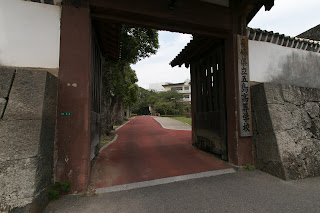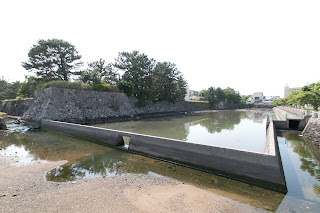Ishida Castle
-Sea castle prepared for threat from the sea-
Overview
Name: Ishida castle (Ishida-jo)
Alias: Fukue-jo (Fukue castle)
Place: Ikeda-cho Goto city, Nagasaki
Type: Flat Castle
Built: 1863
Remaining remnants: Gate, stone walls and moats
Title: 100 more famous Japanese castles
Brief History
Ishida castle (石田城) is built at the center of Fukue area, the center of Goto islands at the east coast of Fukue island. Goto islands is a group of island consist of five large islands and other over 100 small ones, locates about 100 kilometer west from Nagasaki peninsula. It is the western edge of core part of Japan, except for Okinawa islands at far southwestern part of Japan.
Being apart from Tsushima island or Iki island which was mainly used as a communication route toward peninsula and continent, but as a forefront area at East China Sea, Goto island has been also an important place for navigation. In 8th century, envoys of ancient Japan toward Tang Dynasty of China left Goto island and directly sailed westward toward the Yangtze river delta area. Even now, Osezaki lighthouse at the western cliff of Fukue-jima island navigates numerous ships sails the sea.
Origin of Goto clan
Ishida castle was built in 1863, only five years before Meiji revolution. Ishida castle was one of the last Japanese style castles of Japan, along with Matsumae castle completed in 1854, or Sonobe castle built in 1867. Interestingly all of three castle were reformed from existing administrative office, because of urgent necessity of castle and budget limitation.
Goto clan which built Ishida castle had been the lord of Goto island nearly 700 years. The origin of Goto clan is unknown but at first lived at Uku island, the north edge of Goto Islands and named as Uku clan. Later Uku clan moved to Fukue island and became the lord of whole Goto island. In medieval era, Ukushi participated Matsura party, an alliance of small lords spread around northwestern part of Kyushu island.
At the beginning of 16th century Uku clan once lost their territory because of the rebellion of their relative. But after 15 year from rebellion, exiled leader of Uku clan returned to Goto island and ruined rebellion army, being supported by Matsura clan which was the lord of Hirado area and leader of Matsura party later built Hirado castle (Nagasaki prefecture).
Long history lord of islands
In 1540, a Chinese smuggling merchant named Wang Zhi who made trade at wide area around East Asian Sea came to Goto Islands, and Uku clan admitted him to the capital town at Fukue island. It is said that Wang Zhi had a relationship to the arrival of musket guns to Tanegashima island by Portuguese, and there remains the ruin of well built by him at Fukue town.
At the Kyushu campaign of central ruler Hideyoshi Toyotomi (1537-1598), Uku clan followed to Hideyoshi along with Matsura clan. and was approved as the lord of Goto island then named as Goto clan. After participation in foreign expedition, Goto clan became the lord of Fukue domain under Tokugawa Shogunate.
In the former half of Edo era, Fukue domain lost the method of foreign trade by the national isolation policy but prospered by fishery. However, from the middle of the era, decline of fishery and continuous natural disaster significantly damaged the domain. Each leader struggled to improve the situation but the situation of domain became worse and worse.
Threat from the sea
In addition to this, since the beginning of 19th century, Fukue domain had to cope with the threat from the sea. Western fleets once retreated from Japan area by national isolation policy in the former half of 17th century, but because of the fixture of Middle East area and advancement of technology, Western countries started expansion toward Far East area again.
Since the beginning of 19th century, Russian fleets repeatedly visited Japan from northward. On the other hand, Britain, French and United States fleets sailed to Japan from southward, demanding for the supply or foreign trade. There was a trial to occupy unpopulated island, thus Edo Shogunate and each domain had to show their domination to the territory.
Especially Goto island was at the edge of Tsushima straight which separates East China Sea and Sea of Japan. As both seas were the target of Western counties and Russia respectively, there was a fear that Goto Island became the border and might be occupied to take the initiative to the other. Actually there was an accident that Russian fleet tried to stay Tsushima island without permission.
Structure of Goto castle
Based on this situation, in spite of hard financial situation, Fukue domain got the approval from Edo Shogunate to build a castle in 1849. Because of limited budget and manpower, and its location at the next of the sea, the construction of the castle took 14 years. Finally, the castle completed in 1863 and was named as Ishida castle.
Reflecting the situation of the domain, Ishida castle is strongly focused on the defense against the sea and adopted mixed style of traditional Japanese castle and Western fortress same as Matsumae castle (Hokkaido) built at same era.
Overall shape of Ishida castle is like an arrow facing southeast, which was the direction of the sea. Today castle site becomes inland because of land reclamation, but originally East China Sea directly surrounded the castle and castle site was only connected by several bridges to the land.
Central area of the castle is about 100 meter long square area currently used as a ground of high school, which held two corner turret at its eastern line. The main gate of central area existed at the middle of south line, which was a Masugata style combined gate. There were several gates at backside, and residence of the lord might exist inside.
Sea castle prepared for ocean
Secondary area is a trapezoid shaped area of 300 meter long and 200 meter wide wholly surrounds the central area. The main gate of the castle locates at the north eastern edge, and backside gate named Keridashi-mon was built at the northwestern edge of the castle. Both gates were secure Masugata style gate, which were protected by magnificent stone walls and turret gate.
As whole direction of the castle was surrounded by the sea, every part of the wall was built by stone wall. Total length of stone wall exceeds 2 kilometer, and it might be a hard construction for small domain. As the castle was secured by the sea, the height of stone wall is not so high except for the eastern line which faced the sea. Reflecting long construction period, the style of stone wall vary from primitive one to advanced one at each part.
Because of budget limitation and danger to be the target of cannon, there was no tall building except for two corner turret, and the castle was protected mainly by stone wall and fences over that. At the southeastern corner there was a large basement, which might be planned to place the cannon. At the next of main gate, there was a water gate which was directly connected to the sea.
Achievement of short-lived castle
At the north half of central area, there remains the residence of Moriakira Goto (1816-1890), who built Ishida castle but retired before completion. As Moriakira Goto was familiar to the culture of central area, the residence equipped traditional style Japanese garden surrounding the pond. But this garden is decorated by subtropical plans and has an exotic impression compared with the mainland.
The residence is a simple one but decorated by refined decorations. Equipments and wall papers of central and sub writing room fully show the aesthetic sense of the owner. However, reflecting unstable situation, this building also equips armory, evacuation space and a secret passage to outside of the castle.
Ishida castle was used only for nine year, and abolished in 1872. Now large part of water moat surrounded the castle was lost, and major part of the castle is used as grounds of buildings. But stone walls surrounds the castle considerably remains, and the remaining backside gate keeps original atmosphere with water moat and stone walls.
Ishida castle is behind the level of Western fortress at the same age, and it is not clear if it could defend against enemy warships in case of emergency. But by the construction of the castle, it could show the will to protect the territory against the threat from the sea. It was a desperate effort of the domain with limited resources, and was surely rewarded as a preservation of the lands from external threat.
Access
15 minutes bus ride from Fukue Airport at Fukue island of Goto islands.
Related Castles
Matsumae Castle -Half western style coastal fortress-
Hirado Castle -Castle of communication and isolation-

















































































































































































No comments:
Post a Comment